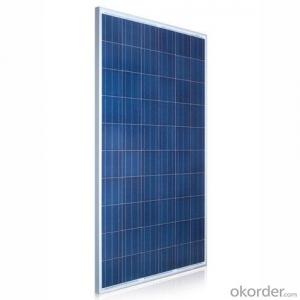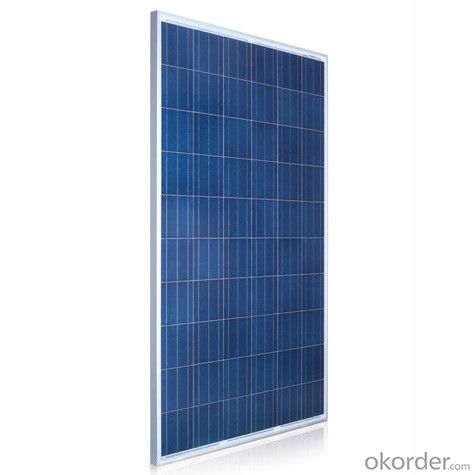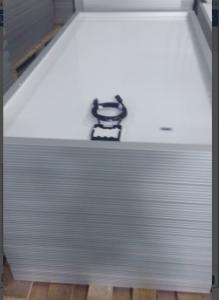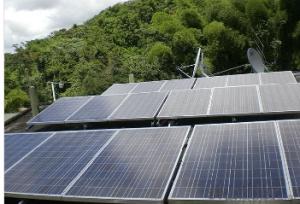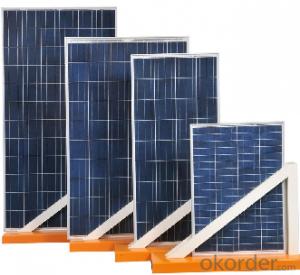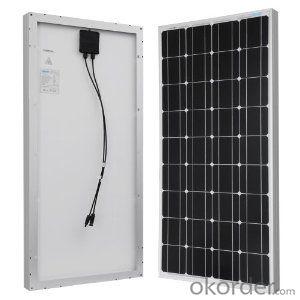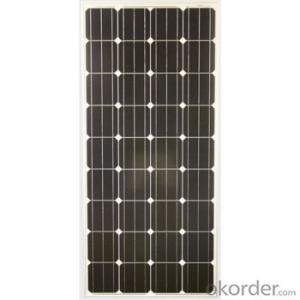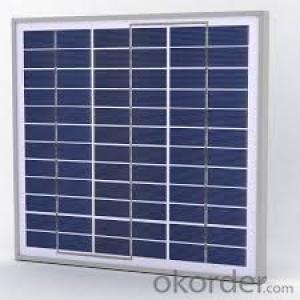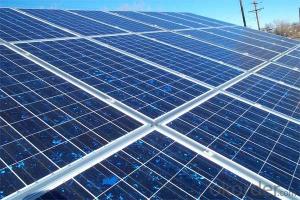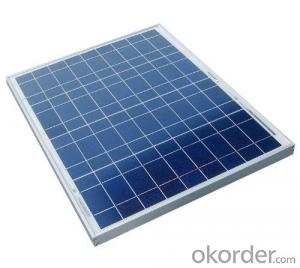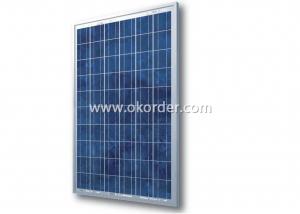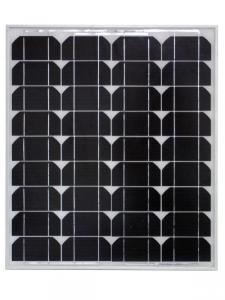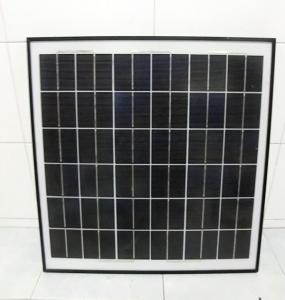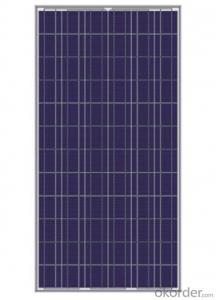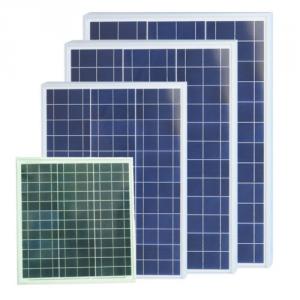350 Watt 1W Poly Solar Panel Small Solar Panel Factory Directly Sale CNBM
- Loading Port:
- Qingdao
- Payment Terms:
- TT OR LC
- Min Order Qty:
- 10 set
- Supply Capability:
- 300000 set/month
OKorder Service Pledge
OKorder Financial Service
You Might Also Like
Polycrystalline Solar Modules
CNBM offers a range of small, medium and large polycrystalline solar modules, designed for a range of requirements.
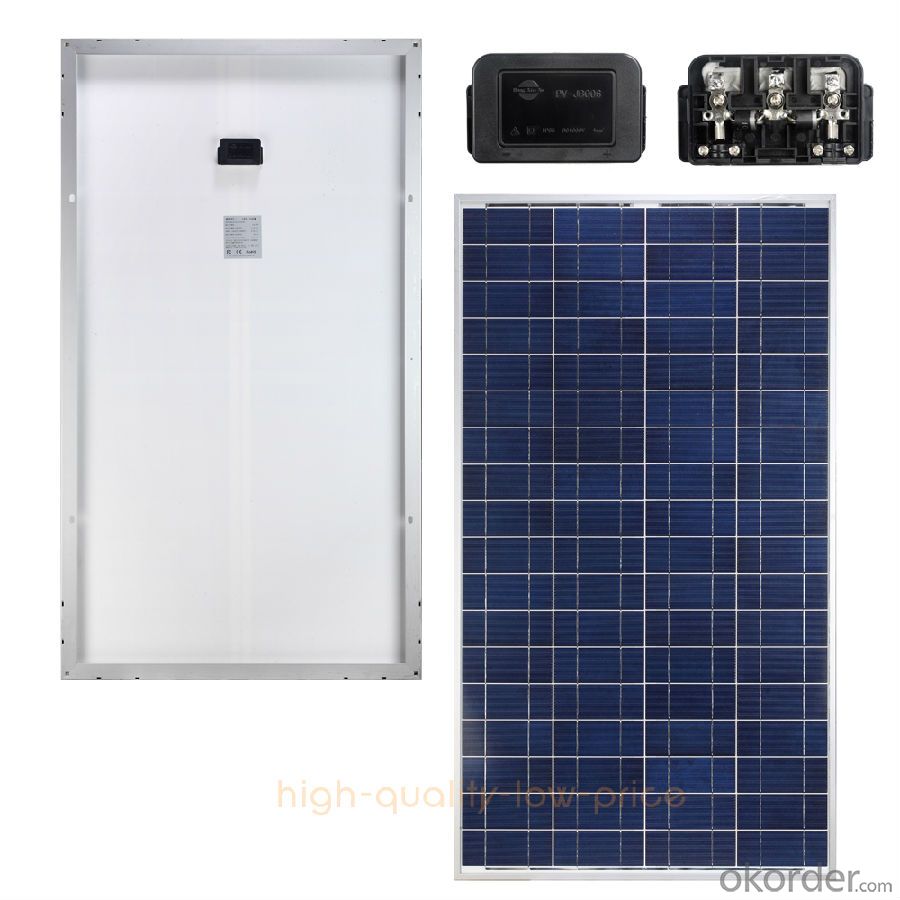
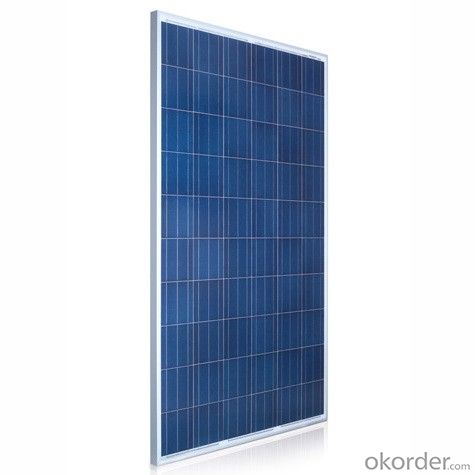
Specifications:
+/-3% |
Polycrystalline silicon solar cells (156 x 156mm) |
60 (10 x 6) |
1650 x 990 x 40 |
25.5 |
Limits:
Operating Temperature | -40~+85? |
Storage Temperature | -40~+85? |
Maximum System Voltage | 1000 VDC max. |
Hail Impact | Diameter of 28mm with impact speed |
Temperature and Coefficients:
NOCT | 48C+/-2? |
Voltage temperature coefficient (%/K) | -0.35 |
Current temperature coefficient (%/K) | 0.05 |
Power temperature coefficient (%/K) | -0.45 |
Characteristics:
Model: | SGM-200P | SGM-210P | SGM-220P |
Max-power voltage Vmp (V) | 29.2 | 29.4 | 29.41 |
Max-power current Imp (A) | 6.85 | 7.14 | 7.48 |
Open-circuit voltage Voc (V) | 36.5 | 36.69 | 36.9 |
Short-Circuit Current Isc (A) | 7.28 | 7.6 | 7.93 |
Max-power Pm(W) | 200 | 210 | 220 |
Model: | SGM-230P |
Max-power voltage Vmp (V) | 29.8 |
Max-power current Imp (A) | 7.72 |
Open-circuit voltage Voc (V) | 37.31 |
Short-Circuit Current Isc (A) | 8.19 |
Max-power Pm(W) | 230 |
STC: Irradiance 1000W/m2, module temperature 25?, AM-=1.5
Poly Crystalline Solar Panels Specifications Range
Maximum Power (Pm) | Dimension | Weight | Operating Voltage (Vmp) | Operating Current (Imp) | Open Circuit Voltage (Voc) | Short Circuit Current (Isc) |
0.45W | 140x80x10mm | 0.08kg | 3.3V | 150mA | 4.6V | 160mA |
1.0W | 162x140x10mm | 0.16kg | 7.5V | 150mA | 10.3V | 160mA |
4.5W | 269x251x23mm | 0.8kg | 16.5V | 0.27A | 20.5V | 0.3A |
10W | 420.1×268.9×22.6mm | 1.92kg | 17.5V | 0.58A | 20.5V | 0.6A |
20W | 425x502x50mm | 3.0kg | 16.8V | 1.19A | 21.0V | 1.29A |
30W | 593x502x22.6mm | 3.9kg | 16.8V | 1.78A | 21.0V | 1.94A |
40W | 655x537x50mm | 5.75kg | 17.3V | 2.31A | 22.1V | 2.54A |
50W | 839x537x50mm | 6.0kg | 17.5V | 2.9A | 21.8V | 3.17A |
65W | 1111x502x50mm | 7.2kg | 17.6V | 3.69A | 22.1V | 3.99A |
80W | 1204x537x50mm | 7.7kg | 17.6V | 4.55A | 22.1V | 4.8A |
- Q: Hello Yahoo, I am doing another one of my wacky inventions however I need something that will give me 2V of power!I don't want to connect loads of AA batteries into a battery holder as this shall run out quickly and become expensive in the long run, I don't want to carry around a big car battery either.I have been searching around on OKorder .uk and found some Solar-Powered 2V Trickle Chargers. These say they shall work on cloudy days (which is perfect as the majority of the time that is all we get!) but could I use it as an independent power source?If I attached the thing I want to run to the solar panel will it supply it with 2V of power?
- How many amps will you need? Remember v x a = power. The way those trickle chargers work is by sacrificing some amperage to get up to 2 volts. If you can invent closer to ~3V range that solar cells naturally produce thing will likely work better. A sign or a light that doesn't need a lot of power will work. Automobile battery packs might take a month to charge. Solar-Powered 2V Trickle Chargers are used mostly to keep things like boat batteries in storage from discharging, not to charge them.
- Q: Can you please tell me how much a solar panel costs?Please back up your info with a website.
- Have okorder . Possibly this could immediately instruct each and every one!
- Q: Ok, so I've been having much success with the joule thief circuit and a LED, but i tried hooking it up to a small solar panel that can put out 2.5v on it's own, and can light up a white LED dimly by it self to the joule thief and it will not work ....my question is why? I already trouble shooted it, the circuit is not the problem, is it the amount of amps the small solar panel is capable of? not enough?
- Solar panels convert light energy to electrical energy with an efficiency of around 5%. A SMALL solar panel will only produce a small amount of power (watts) your joule thief circuit wont help because as you draw more current from the solar panel the voltage will drop; and your joule thief circuit just reduces the efficiency of the whole system Try adding another solar cell in series to get more voltage and more power.
- Q: Can solar panels be installed on desalination plants?
- Yes, solar panels can be installed on desalination plants to generate renewable energy and help power the plant's operations. This integration of solar power can reduce the reliance on fossil fuels and make the desalination process more sustainable.
- Q: Can solar panels be installed on a fire station or emergency services building?
- Yes, solar panels can be installed on a fire station or emergency services building. In fact, many fire stations and emergency services buildings have embraced solar energy as a sustainable and cost-effective solution for their power needs. Solar panels can be installed on rooftops, parking lots, or open spaces surrounding these buildings to harness solar energy and generate electricity. This helps reduce their reliance on traditional energy sources, lowers operating costs, and contributes to a cleaner and greener environment.
- Q: so...do you think an online store dedicated to selling solar panels/systems will be a good business idea? Since green energy is the 'hottest' growing business area recently with usage growing about 30% per annum and investors putting all their money into solar energy, wind farms, biofuel, etc. I think when you sell solar systems online this will be the most appealing business model to the end customer...especially if you offer free installation on orders of say $000.
- My guess is that you must discover everything concerning green energy at www.okorder .
- Q: but is that per day, per hour or minute?How much watts does the average AC unit use?How much does an energy efficient lightbulb use?All in all let's hypothetically say we no longer use the electric company for our energy source, How many of these panels do you estimate it would take to supply our small home?
- To calculate an estimate of your power usage, follow the first link below. Although you can have whatever sized system you want (at a cost) those on solar power generally keep their power usage down by cooking on gas, not using an electric kettle, using low energy light bulbs. Powering AC would up your power requirements considerably. We run a medium sized house on 860 watts of panels in southern Spain (plenty of sunshine). That includes the washing machine, pool, and running two laptops and wireless network all day,and a ceiling fan on summer nights. Hower we cook on gas, would not consider AC, and the fridge runs on gas (though if the fridge had to be replaced I would buy electric and add an extra pv panel). For an overview of the equipment required and what it does, check the second link below.
- Q: Can solar panels be installed on greenhouses?
- Yes, solar panels can be installed on greenhouses. In fact, it is a popular practice as it allows for dual benefits - generating clean energy while also providing shade and protection to the plants inside the greenhouse.
- Q: China is building solar panels and have been for years. That is the most abundant energy in the world. My nieghbor has two panels on his roof and he actually sells energy back to the electric company. These panels cost about $30,000. each, because we don't produce them here on that level.If we did, that price would drop drastically. Other alternatives are also available. Drilling for oil will no change anything. Once you give the oil companie the go ahead, the will focus on that and the alternatives won't be developed any farther. We will be right back here in about 0 years. The price will not go down anyway. So why not switch half of our fuel to alternatives?
- I visit hundreds of houses a week in my line of work and there are houses in neighborhoods that aren't the wealthiest that have solar. It might be cheaper than you think.
- Q: What's your opinion on solar power? More specifically, having panels installed on your roof to reduce your electric bill. I'm having a consultation tomorrow to get more details. I live in the SW, so it's always crazy sunny here. I don't know what the cost will be yet. Is it something you'd consider if the situation was right? If not, why?
- Just had them installed on a development of 4 homes and they look goood! So far each user has free electricity during daytime for 3/4 of the year. If you live in a hot country - that's free A/C to keep you cool. The downside is that it is grid-tied so there is no storage, which means that if you use electricity to cook the evening meal - you don't get that free. What we advise to do instead is to make use of slow cookers that cook meals during the day - for FREE, and just serve it up in the evening as it keeps the heat. It would be more effective if you used storage radiators and heated hot water tanks for washing/bathing using it but this hasn't been added yet. It's free power all day - so what is there to complain about? The only catch I have found is that some power companies charge YOU if you export power to the grid - so just watch out for that, and design your system to avoid this if this applies, but most just don't pay anything - so you may as well use what you get.
Send your message to us
350 Watt 1W Poly Solar Panel Small Solar Panel Factory Directly Sale CNBM
- Loading Port:
- Qingdao
- Payment Terms:
- TT OR LC
- Min Order Qty:
- 10 set
- Supply Capability:
- 300000 set/month
OKorder Service Pledge
OKorder Financial Service
Similar products
Hot products
Hot Searches
Related keywords
